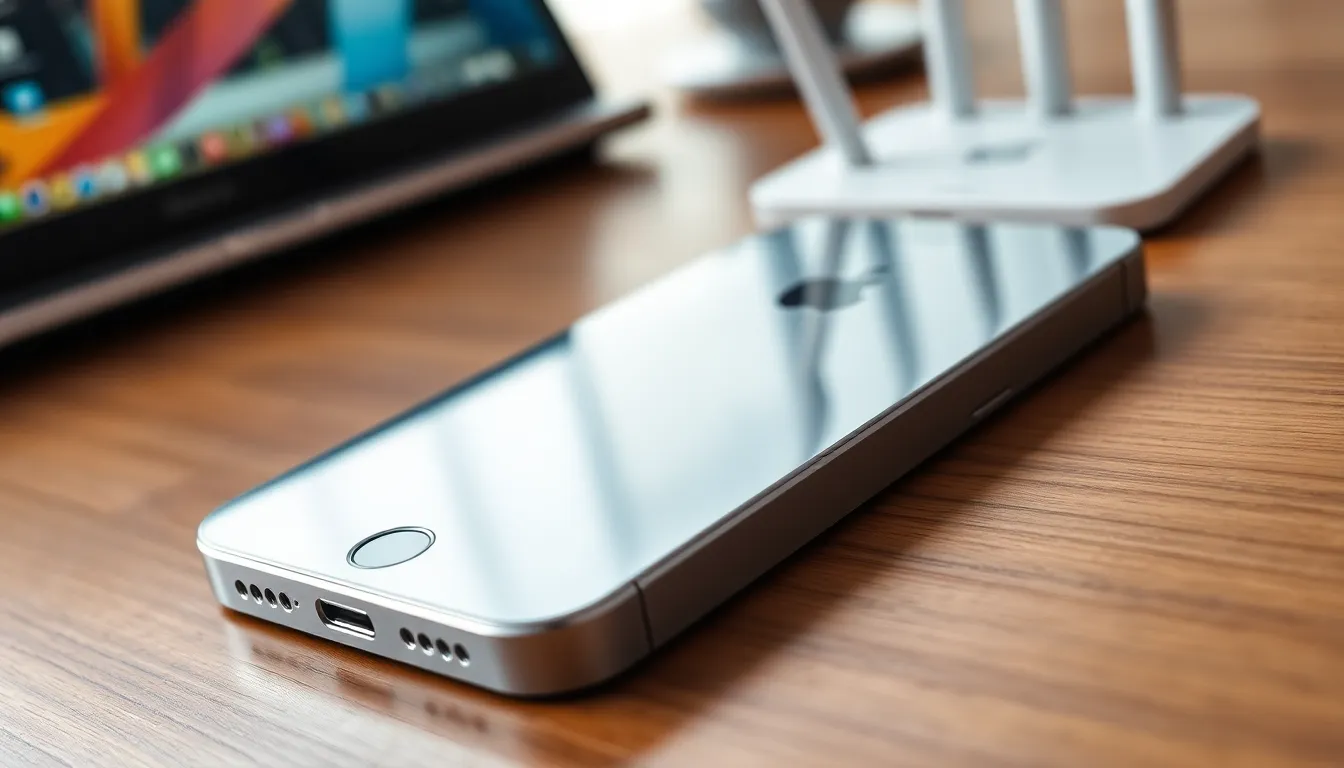In a world where technology races ahead faster than a caffeinated squirrel, the iPhone 5s stands as a nostalgic relic of simpler times. Released in 2013, this smartphone was a game-changer, but does it have what it takes to keep up with today’s lightning-fast 5G networks? Spoiler alert: it doesn’t.
While the iPhone 5s was a pioneer in its day, offering features that dazzled users, it’s now stuck in the slow lane. With 5G taking the world by storm, it’s time to face the music—this little powerhouse just can’t keep up. Join the journey as we explore why your beloved iPhone 5s won’t be joining the 5G party anytime soon, and discover what that means for your daily digital life.
Table of Contents
ToggleOverview of iPhone 5s
Released in 2013, the iPhone 5s introduced advanced features for its time. It represented Apple’s first venture into 64-bit architecture, boosting processing speeds with the A7 chip. The device featured a 4-inch Retina display, which was considered sharp and vibrant. A Touch ID fingerprint sensor added security and convenience for users.
However, the iPhone 5s faces significant limitations in connectivity. Designed before the rollout of 5G technology, it exclusively supports 3G and 4G LTE networks. This absence of 5G compatibility restricts users from enjoying faster internet speeds and improved streaming capabilities. Many modern applications and services require higher bandwidth, reducing the iPhone 5s’s functionality in today’s digital landscape.
Available in gray, silver, and gold finishes, the iPhone 5s maintained a stylish appearance. Its compact design appealed to users seeking portability. Despite its elegance, the device struggles to run demanding applications smoothly. Operating on iOS, its software updates are minimal and no longer include major enhancements.
In comparison to later models, the iPhone 5s’s performance lags behind newer releases. Users experience slower processing and limited app compatibility as good connectivity becomes crucial. The device remains a nostalgic choice but fails to meet contemporary digital requirements. With the shift toward higher network standards, relying on the iPhone 5s may not fulfill modern smartphone expectations.
Understanding 5G Technology

5G technology represents the fifth generation of mobile networks, offering significant advancements over previous generations. This technology provides faster speeds, lower latency, and enhanced connection reliability.
What Is 5G?
5G is a network designed to support new and emerging technologies. It’s capable of delivering speeds up to 10 Gbps, which is substantially faster than 4G LTE’s maximum of 1 Gbps. Increased bandwidth allows for more devices to connect simultaneously without a slowdown in performance. It relies on a combination of higher frequency bands and advanced network architecture, unlocking opportunities for various applications such as smart cities, autonomous vehicles, and augmented reality.
Advantages of 5G Connectivity
5G connectivity brings numerous advantages to users and industries alike. Enhanced speed enables quicker downloads and seamless streaming of high-definition content. Low latency ensures minimal delay during communication, crucial for real-time applications like gaming and video calls. Improved capacity supports a vast number of connected devices, facilitating the growth of the Internet of Things. Businesses benefit from increased operational efficiency, allowing for innovations that drive productivity and enhance customer experiences. Overall, 5G connectivity transforms the digital landscape, making it essential for future technological developments.
Device Compatibility
The iPhone 5s lacks compatibility with 5G networks. Understanding device support for 5G is crucial for users wanting to utilize modern connectivity.
5G Support in Smartphones
5G support varies widely among smartphones. This next-generation technology provides substantial benefits over its 4G predecessor, including improved speed and lower latency. Specific chipsets facilitate 5G connectivity, enabling devices to handle demanding applications and deliver robust performance. All smartphones designed for 5G are optimized with advanced antennas and networking capabilities, ensuring seamless connectivity across different environments.
iPhone Models That Support 5G
Several iPhone models offer 5G support. Starting with the iPhone 12 series, Apple introduced 5G capability into its lineup, providing access to faster downloads and enhanced streaming experiences. The iPhone 13 series and iPhone 14 also include 5G support, expanding the options for users who prioritize high-speed internet. Users with these models can fully exploit 5G technology, benefiting from increased connectivity and the latest features in mobile applications.
Does iPhone 5s Support 5G?
The iPhone 5s does not support 5G connectivity. Released in 2013, this model only accommodates 3G and 4G LTE networks, significantly limiting its compatibility with modern technology.
Technical Specifications of iPhone 5s
The iPhone 5s features the A7 chip, which introduced 64-bit architecture, allowing it to handle certain applications with improved efficiency. Equipped with a 4-inch Retina display, it delivers decent visuals for its time, but it lacks the processing power of newer models. Its camera capabilities include an 8-megapixel rear camera, capable of capturing clear images for social media sharing. Additionally, the device supports up to 64GB of storage, falling short of the larger capacities offered in contemporary smartphones. These specifications highlight its technological limitations compared to current devices.
Network Capabilities of iPhone 5s
The network capabilities of iPhone 5s only extend to 3G and 4G LTE. Consequently, users cannot access the benefits of faster 5G networks, which include significantly improved download speeds and reduced latency. A limitation arises when attempting to connect to modern applications that rely on high-speed internet. While 4G LTE offers reasonable performance, it pales compared to the capabilities of 5G, which can achieve speeds up to 10 Gbps. Users of the iPhone 5s may experience sluggish performance during data-heavy activities, particularly with content streaming or online gaming. This lack of 5G support further underscores the device’s struggles in today’s digital landscape.
The iPhone 5s, while a notable device in its time, simply can’t keep up with the demands of today’s digital landscape. Its inability to support 5G networks limits users from experiencing the speeds and capabilities that modern applications require. As technology continues to advance, the importance of 5G compatibility becomes increasingly clear.
For those still using an iPhone 5s, considering an upgrade to a more recent model could significantly enhance their digital experience. Newer iPhones not only support 5G but also offer improved performance and features that align with the fast-paced world of technology. Embracing these advancements ensures users can fully enjoy everything the digital age has to offer.




